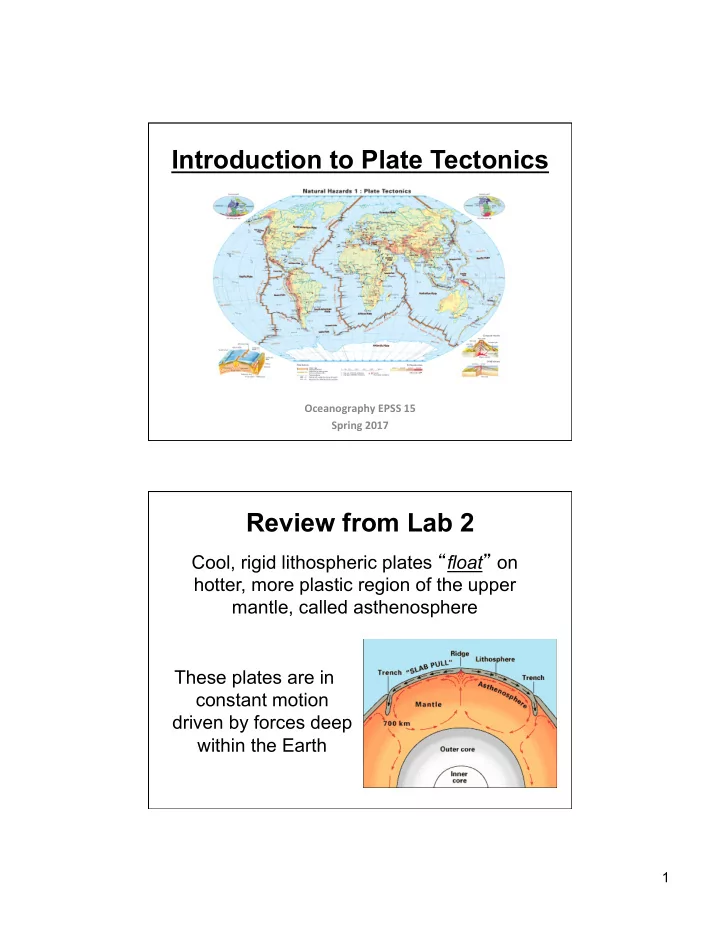

Introduction to Plate Tectonics Oceanography EPSS 15 Spring 2017 Review from Lab 2 Cool, rigid lithospheric plates “ float ” on hotter, more plastic region of the upper mantle, called asthenosphere These plates are in constant motion driven by forces deep within the Earth 1
Basics of Plate Tectonics The Earth ’ s crust is constantly being recycled – New lithospheric material is created at mid-ocean ridges where it moves outwards due to sea-floor spreading – Lithospheric material is ul<mately destroyed by the process of subduc<on Different Types of Plate Boundaries 2
Divergent Plate Boundary – Two plates move away from each other (e.g., MOR, Gulf of California) – Rising asthenosphere pushes ridges apart (sea-floor spreading) – New basal<c crust is being created Types of Divergent Plate Boundaries Oceanic Ridge and Rise System • Shallow earthquakes • High heat flow, volcanic activity • e.g., Mid-Atlantic Ridge, East Pacific Rise Young (Juvenile) Ocean Basins • Very young rift and ridge systems e.g., Gulf of California, Red Sea On-land Rifting • Continents that are spreading apart may become ocean basins • High heat flow, volcanic activity e.g., East African Rift Valley, Rio Grande Rift 3
Convergent Plate Boundary – Boundary where two plates move towards each other – Subduc<on occurs (most cases) • Denser plate sinks (subducts) beneath less dense plate • Genera<on of magma<c arcs, parallel to trenches Types of Convergent Plate Boundaries Ocean-Ocean Convergence • Subduction of one oceanic plate beneath another • Older, colder plate is subducted under younger, warmer one • Associated with deep trenches and volcanic island arcs that are parallel to the trench e.g., Tonga, Aleutians Ocean-Continent Convergence • Subduction of more dense oceanic plate beneath continental plate • Associated with deep ocean trenches near continental volcanic arcs e.g., Andes, Cascades Continent-Continent Convergence • Since both continental plates are low-density, neither is forced into asthenosphere; instead plates are pushed up • Mountain building occurs, crust becomes highly deformed e.g., Himalayas, Alps 4
Convergent Plate Boundaries Additional Information • Earthquakes at convergent boundaries: – Shallow (0-30 km) – Intermediate (30-400 km) – Deep (400-700 km) Deep Volcanic arc ocean trench î • Heat flow is low at trenches and high at volcanic arcs! – Why??? 5
Transform Plate Boundaries • Boundary where two plates are moving in parallel, but opposing direc<ons • Low heat flow, shallow earthquakes • Right-lateral or leM-lateral e.g., San Andreas fault fracture zone fracture zone Transform Plate Boundaries 6
Intraplate Regions and Hotspots • Sta<onary plumes of magma erupt through a plate that is moving over it • Forms chains of ex<nct volcanic islands termina<ng at the ac<ve (youngest) volcanic island • e.g., Hawaiian islands, Emperor Seamounts Pacific Plate Mo<on 7
Hot Spot Motion Moving Rate - Sample calculation : Distance between oldest and youngest volcano: 2,000 km Time period: 20 Ma Moving rate (cm/year) = 2,000 km / 20 Ma = 10 cm/year 2,000 km 8
Recommend
More recommend